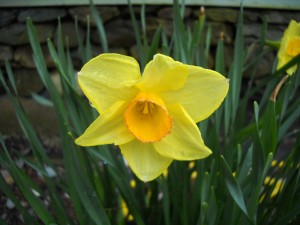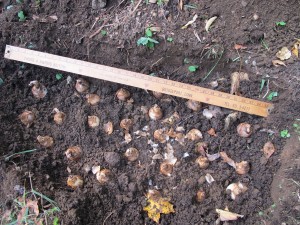Planting Bulbs
This is one of my favorite times of the year. Trees are turning brilliant colors, food from the garden is in the larder, and it’s bulb planting time. Some bulbs have a bad reputation: tulip bulbs for example, are often food for squirrels, and their blossoms are often munched by deer. But I know that if I plant daffodils, I’ll get blossoms six or seven months later and nothing will even think about eating them. Daffies are sure winners.
Daffodils will thrive and survive in sun or part shade. I grew up in Connecticut in a house that had a nice wooded back yard and a path through it that was lined with hundreds of daffodils. Maybe thousands. They multiplied and survived and bloomed year after year.
The soil was a dark woodland soil nourished by decomposing leaves. There was good drainage – which is important, as bulbs can rot if planted in heavy, wet soil. Occasionally my parents would dig up some big clumps and divide them, but really, we did almost nothing and the daffodils thrived.
I called Brent and Becky’s Bulbs, a family-owned business in Virginia to talk about my experience with daffodils. Their catalog says daffodils need half a day of sunshine even after the leaves come on. Why, I asked owner Becky Heath, did those daffodils of my youth do so well in our woods?
Becky said that daffodils do best in nutrient-rich soil. Our soil was that. She also said that some types do better than others. There are more than a dozen categories of daffodils, and of these, the Cyclamineus group includes many of the most shade-tolerant varieties. These are not the classic daffodil: their petals lean backward, away from their trumpet – sort of like the ears of a dog with his head out the window of a fast moving car.
Becky also told me that daffodils in the Cyclamineus group also do better than other types of daffodils in wet, heavy clay soils. ‘Tweety Bird’, ‘Jack Snipe’ and ‘February Gold’ are examples in this group.
If you read a package of daffodil bulbs carefully, you will probably see that each variety is labeled Early, Mid-Season or Late. In the past I have always selected some from each time period. But Becky Heath suggested to me that I focus primarily on bulbs that bloom early because much of my property is getting quite shady – especially where I want to plant bulbs – and early bloomers do better in part shade than late bloomers. Examples of early spring daffodils include ‘Rijnveld’s Early Sensation”, and many of the miniature varieties.
Bulbs expend a huge amount of energy in order to produce flowers. Those bulbs need to be “re-charged” each year or they will decline and have less energy for blooming next year. They do this through the miracle of photosynthesis – sunshine on their leaves produces food for the bulbs. Leaves on early-blooming bulbs generally come up and get to work early in the spring – before trees have leaves. If a bulb can get the needed energy before the leaves appear, it will thrive. Many daffies still have green leaves through June.
That theory is supported by this: my snowdrops and Scilla and Glory-of-the-Snow have thrived and multiplied, even in shade. They are small flowers that come up in March, long before the maples have leafed out. They have done much better than the daffodils planted near them.
According to Becky Heath, another factor in the success or failure of bulbs is whether or not they are hybrids. Hybrids don’t self-pollinate and re-seed themselves. Those that are called “species” daffodils do spread and naturalize by seed, she said. Thus some of the older varieties do better than the “new, improved” hybrids.
Some gardeners plant bulbs one-by-one with a little tool that can dig a round hole when plunged into the soil. I find that hard work, and slow. I prefer to dig one big hole that will hold 25 bulbs or more. I dig the hole, add some organic fertilizer and scratch in some compost. I want daffodils to have about 6 inches of soil covering the bulbs, or less for the small bulbs.
After a long winter, I long for color. You may think of daffodils as just one color – yellow – but some varieties can offer white, orange, pinkish peach, and lots of variations of colors I can’t name. But whatever you choose, plant some bulbs now for a punch of color in the spring.
Henry’s e-mail address is henry.homeyer@comcast.net, or you may reach him at P.O. Box 364, Cornish Flat, NH 03746. If you have a question, please include a self-addressed stamped envelope.




